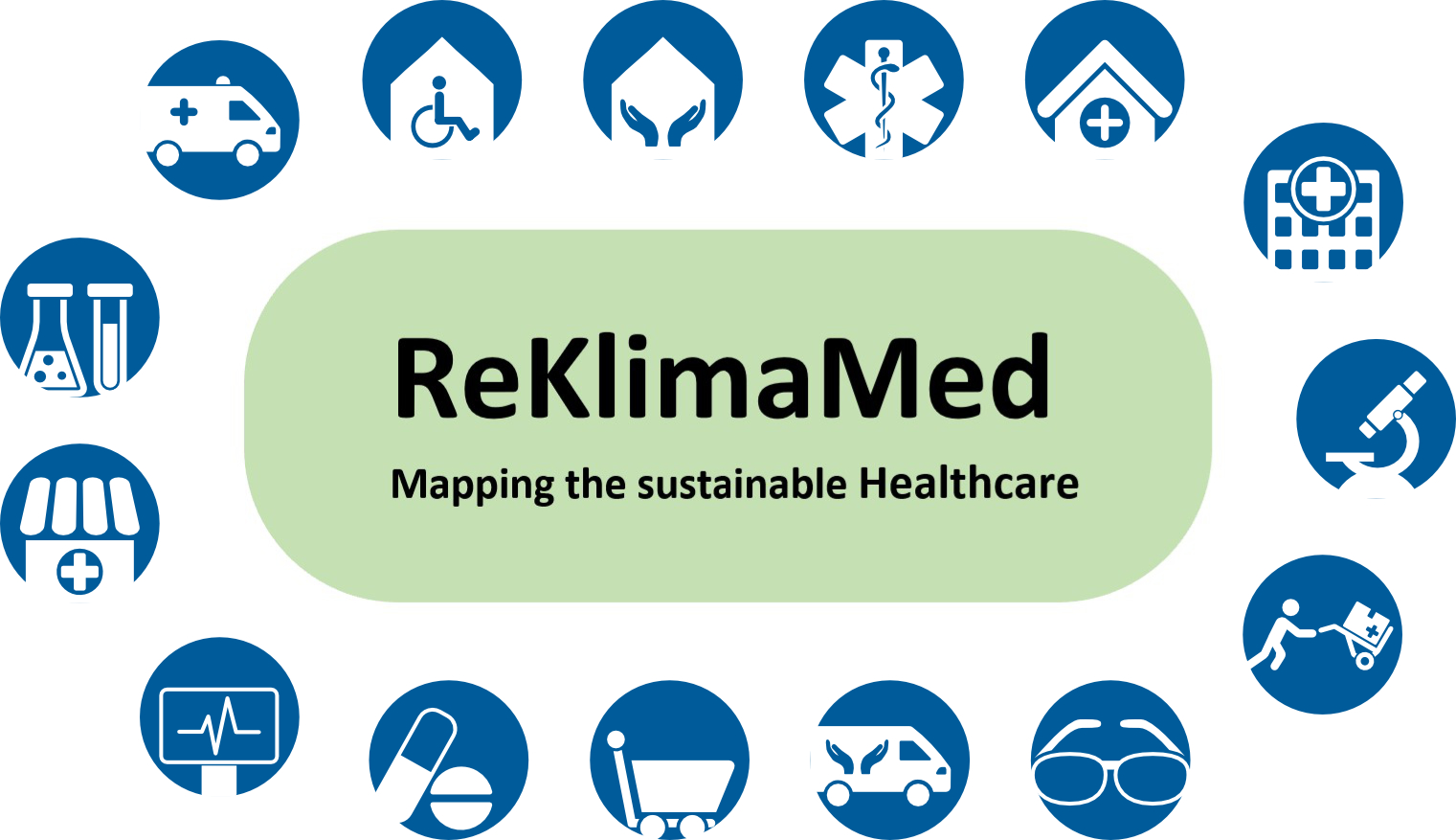Sustainability report
ReKlimaMed: how effective is the German healthcare sector when it comes to sustainability?
Hospitals, care facilities and the healthcare industry, together with laboratories, private practices and pharmacies, ensure our medical care, but in so doing they produce enormous amounts of greenhouse gases and consume many resources. The ReKlimaMed report prepared by the viamedica foundation presents an inventory of current sustainable activities, and provides stakeholders with information and recommendations for action.
Sustainable action in all areas of life is needed to meet the requirements of the European Climate Law. This obliges EU Member States to reduce net greenhouse gas emissions by at least 55 percent by 2030 as compared to 1990. This law is challenging for the healthcare sector, which has a huge ecological footprint. In Germany, the healthcare sector causes around five percent of national CO2 emissions and consumes enormous quantities of raw materials.1) "For a long time, the healthcare sector only saw the negative effects of climate change on physical well-being. People are now increasingly becoming aware that the sector itself contributes significantly to the problem," explains Markus Loh, project manager at "viamedica –Foundation for a Health Medicine". The Freiburg-based non-profit foundation was founded by the physician Prof. Dr. Franz Daschner and has been working for over 20 years to systematically implement environmental protection in the medical sector.
ReKlimaMed records sustainable activities in the healthcare sector
 Under the leadership of Markus Loh, ”viamedica - Foundation for a Healthy Medicine” - has produced ReKlimaMed, an inventory of resource efficiency, climate protection and ecological sustainability in the German healthcare sector. © viamedica
Under the leadership of Markus Loh, ”viamedica - Foundation for a Healthy Medicine” - has produced ReKlimaMed, an inventory of resource efficiency, climate protection and ecological sustainability in the German healthcare sector. © viamedicaIn 2022, on behalf of and with financial support from the German Federal Ministry of Health, viamedica produced an inventory of resource efficiency, climate protection and ecological sustainability in the German healthcare sector. Loh explains: "The ReKlimaMed report is a snapshot, a qualitative analysis that is intended to provide recommendations for action. We compiled current sustainability activities and identified their advantages as well as the obstacles that prevent them from being implemented."
The healthcare sector was initially divided into fifteen areas, each of which was examined in more detail according to seven different themes (see info box). Extensive online and literature searches were carried out to collect freely accessible information on sustainable measures in companies, healthcare facilities and private practices. It quickly became apparent that of the 1,887 hospitals in Germany, only a few really implement ecological sustainability in a structured way as a fixed process. Therefore, discussions with employees and guideline-based interviews with stakeholders were also conducted. The detailed results of the seven-month research project are available on the viamedica website.
"There are some measures that we found in all areas, such as the use of LED lighting, modern lighting control and the switch to green electricity or electric mobility," Loh reports. "These can be implemented easily, even in small facilities, and quickly generate energy savings. However, we mostly saw a lack of information material about which measures make sense and which approach is best." Within the framework of ReKlimaMed, viamedica has therefore developed concrete recommendations for action for each area in order to introduce the idea of sustainability.
The concept of sustainability must be part of corporate management
The diverse tasks hospitals carry out and the services they provide offer a wide variety of starting points for sustainable, climate-neutral and resource-efficient operation. Viamedica has found that measures not being clearly adopted at management level was the single biggest obstacle to their implementation. As Loh says: "The process must originate from hospital management and become an integral part of management structures. People responsible for coordinating the activities need to be appointed and given a budget; for example, there needs to be a post that focuses specifically on sustainability. This is the only way continuous change is possible." However, since incentives and regulatory requirements are largely lacking, the process has so far mainly been based on individual initiative.
Hospitals have many options
Comprehensive and high-quality medical care consumes large quantities of energy, water and resources, but also has much potential for savings. The commonly used anaesthetic gas desflurane, for example, is 2,540 times more potent as a greenhouse gas than CO2; a 7-hour operation is thus equivalent to a car journey of 15,000 km (over 9,000 miles).2) By using sevoflurane (a gas that causes less harm to the climate but which is nevertheless 130 times more potent than CO2) can reduce the emissions of an anaesthesia department by as much as 67 percent. Anaesthesia services currently account for about one third of a hospital's total emissions. Anaesthetic gas filters can also be installed to collect and recycle the gas used. In summer 2022, Baden-Württemberg was the first German state to draw up government guidelines for this. The overall cost of equipping Baden-Württemberg’s two hundred hospitals is expected to amount to only 500,000 euros – a manageable sum that would have a huge effect.
A similarly good cost-benefit ratio for the environment can be achieved by completely shutting down ventilation and air-conditioning systems in operating theatres outside operating hours.3) This procedure, which has been practised in Austria for a long time, was implemented in Germany at the Carl Gustav Carus University Hospital in Dresden in 2013. An initial investment of 1,500 euros per operating theatre has led to energy use reduction of around 1,000 kilowatt hours and generated cost savings of 2,500 to 3,000 euros per operating theatre per year. However, since there are often concerns about hygiene and the administration involved, most hospitals do not consider this option.
The Charité hospital in Berlin has opted for a completely different measure that is easy to implement: it only uses textiles with the Green Button state sustainability label for textile production. The general recommendation is to use reusable products, resource-saving materials and digital recording or documentation methods.
Unfortunately, only 23 hospitals in Germany are European Eco-Management and Audit Scheme (EMAS) certified, including the hospital in Karlsruhe. "But more and more hospitals are seeing the value of pursuing certification. The EMAS system can also serve as a guiding principle, as hospitals can work through the requirements one by one," explains Loh.
The new Klinikum Frankfurt-Höchst building is a real flagship project. The so-called maximum care provider is the world's first Passive House hospital and is expected to save up to 90 percent of its standard heating costs in the future. ReKlimaMed identified the dual financing system in Germany as a major obstacle to sustainable hospital buildings of this kind. Under this system, construction costs are borne by the state, and the hospital pays for the operating costs and subsequent investments. That said, effective climate protection requires a joint concept that takes into account the entire life cycle costs of buildings.
Large industrial companies as role models
 The ReKlimaMed report looks at 15 different areas of the healthcare sector. © viamedica und R. Menßen-Franz
The ReKlimaMed report looks at 15 different areas of the healthcare sector. © viamedica und R. Menßen-FranzIn the healthcare industry, ReKlimaMed covers the pharmaceutical, medical technology, ophthalmic optics and biotechnology industries. EMAS-certification in these industries is also very low, with 0.5 to three percent of companies being certified. However, a much higher proportion of companies are addressing the issue of sustainability; energy and raw materials consumption has been decreasing significantly for many years; less wastewater and waste is produced, and the quantity of greenhouse gas emissions is falling. Financial savings have been identified as the biggest incentive for implementing sustainability measures. However, changes in the production process are often countered by high safety requirements and associated regulatory measures.
Large, internationally active corporations in particular are setting a good example. Pfizer, for instance, covers 90 percent of its energy needs at its largest production site in Freiburg with renewable energies; Roche has introduced EMAS at its plants in Mannheim and Penzberg. The healthcare sector needs to adopt the idea of sustainability at management level, in the same way as sales and development are doing. Loh believes that linking subsidies to sustainable activities is a potential incentive, especially for smaller companies.
"There are some standouts in the healthcare sector, but there is still a huge need for action. That's why we are hoping to talk to umbrella organisations, as they are the ones who can raise public awareness," says Loh, referring to the way forward. "We have also seen in all areas that climate protection and sustainability have a positive external effect. The public face of many companies and institutions showcases the climate and sustainability and increasing numbers of job applicants are looking at sustainability as a key criterion when it comes to choosing an employer."
Info box: ReKlimaMed: Resource efficiency, climate protection and environmental sustainability in the healthcare sector - taking stock
Division of the healthcare sector into the areas of:
Hospitals, rehabilitation facilities, outpatient and inpatient care facilities, medical/dental practices/medical care centres, emergency services, medical/dental laboratories, municipal health offices, pharmacies, opticians/medical stores/hearing aid specialists, purchasing groups, pharmaceutical industry, medical technology industry, ophthalmic optics industry and biotechnology industry.
Analytical framework:
Building energy, mobility, materials and services procurement, user behaviour, sustainability management, waste management, resource efficiency
Evaluation:
Advantages/barriers, flagship projects, recommendations for action, conclusion